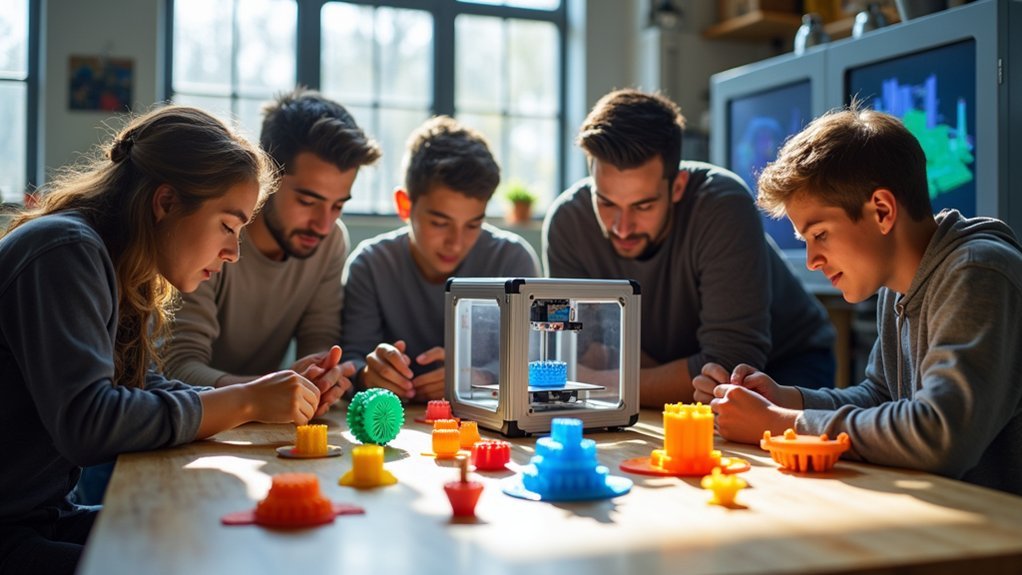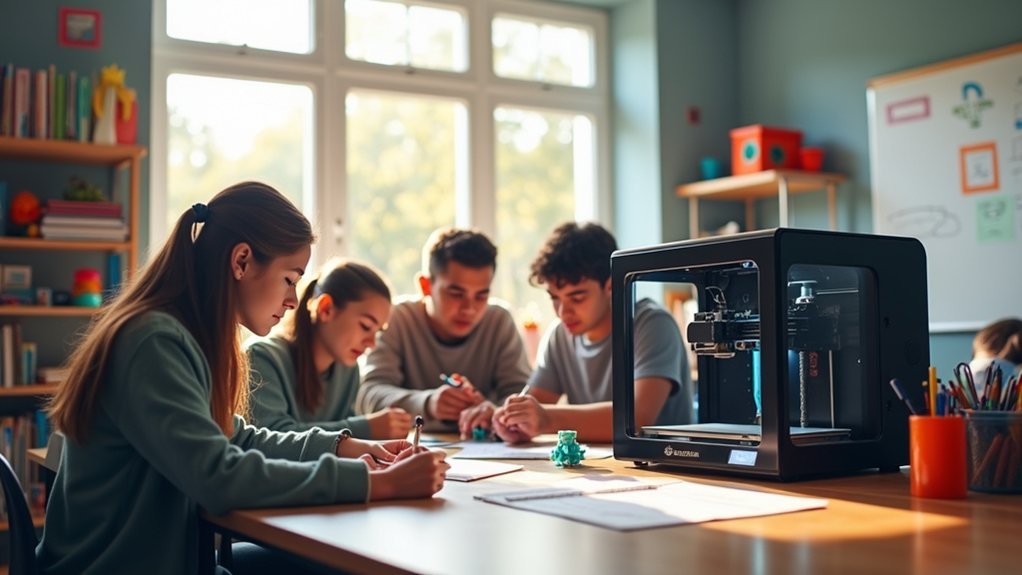3D printing transforms engineering education by turning abstract concepts into physical prototypes you can touch, test, and iterate. You’ll develop critical problem-solving skills through rapid prototyping, strengthen spatial visualization beyond textbooks, and gain hands-on experience with real-world design challenges. This technology bridges theory and practice while building digital literacy through CAD integration and fostering innovative thinking about materials and functionality. Discover how these revolutionary learning approaches are reshaping tomorrow’s engineers.
How 3D Printing Bridges Theory and Practice in Engineering Classrooms

While engineering students have long struggled to visualize abstract concepts from textbooks and lectures, 3D printing transforms these theoretical concepts into physical prototypes they can hold, examine, and test. This technology revolutionizes engineering education by giving you hands-on experience that bridges classroom theory with real-world design and manufacturing challenges.
You’ll develop practical skills through rapid prototyping, where you can quickly iterate designs based on immediate feedback. This iterative design process strengthens your critical thinking abilities as you identify problems, test solutions, and refine concepts.
Studies demonstrate that when you engage with 3D printing projects, your spatial visualization improves considerably. You’re no longer just memorizing formulas—you’re actively creating, testing, and understanding how engineering principles work in practice, preparing you for professional success.
Essential Skills Students Develop Through Hands-On 3D Printing Projects
When you engage with hands-on 3D printing projects, you’ll naturally develop design and creativity skills as you transform abstract concepts into tangible models.
You’ll find yourself thinking more innovatively about spatial relationships and aesthetic choices while maneuvering the constraints of printable geometry.
Through prototyping iterations, you’ll sharpen your problem-solving abilities by identifying design flaws early and developing creative solutions to overcome material limitations and printing challenges.
Design and Creativity Skills
As students engage with 3D printing projects, they’ll discover that transforming abstract concepts into tangible prototypes fundamentally reshapes how they approach design challenges.
You’ll develop enhanced design skills as you create physical objects that demonstrate engineering concepts in ways textbooks can’t match. The iterative design process becomes your creative playground—you’ll modify, test, and refine prototypes based on real-world feedback, strengthening your problem-solving abilities.
Working with CAD software alongside 3D printing boosts your digital literacy while fostering critical thinking. You’ll constantly evaluate how digital models translate into functional objects.
Collaborative projects amplify creativity as you brainstorm with teammates, combining diverse perspectives to innovate solutions. This hands-on approach transforms abstract theories into concrete understanding, preparing you for modern engineering careers where creativity meets technical precision.
Problem-Solving Through Prototyping
Through rapid prototyping with 3D printing, you’ll master the trial-and-error methodology that defines effective engineering problem-solving. This hands-on approach transforms abstract concepts into tangible prototypes you can test and refine.
You’ll develop critical testing skills by evaluating your designs against real-world applications, identifying weaknesses and optimization opportunities immediately. The iterative process encourages you to embrace failure as valuable feedback rather than defeat.
When troubleshooting printing issues or design flaws, you’ll strengthen your problem-solving abilities through direct experience. Each prototype cycle teaches design optimization principles, from material selection to structural integrity considerations.
This prototyping methodology reduces your fear of mistakes while building resilience essential for tackling complex engineering challenges. You’ll gain confidence in your ability to iterate, improve, and ultimately create solutions that perform effectively in practical applications.
Real-World Applications That Enhance Engineering Learning Outcomes

While traditional engineering coursework often relies on theoretical examples, 3D printing transforms education by connecting students directly to real-world challenges that demand practical solutions. You’ll engage in hands-on projects that cultivate creativity and innovation while developing essential spatial visualization skills through iterative design improvements.
| Real-World Application | Learning Outcome |
|---|---|
| Custom prosthetics design | Enhanced practical problem-solving abilities |
| Community partnership projects | Improved design thinking processes |
| Functional tool creation | Strengthened engineering concept retention |
| Environmental solutions | Advanced spatial visualization skills |
When you participate in collaborative initiatives like the Mystic Aquarium partnership, you’re applying engineering principles to create tangible community impacts. These real-world applications in engineering education demonstrate how 3D printing bridges theoretical knowledge with practical implementation, resulting in markedly improved learning outcomes and academic performance.
Overcoming Implementation Challenges in Educational Institutions
Despite the clear benefits of integrating 3D printing into engineering curricula, you’ll likely encounter significant obstacles when implementing this technology at your institution.
Integration challenges begin with high initial costs for quality equipment and ongoing material expenses that strain budgets. Your faculty will need thorough professional development to build confidence with 3D printing technology, as unfamiliarity leads to underutilization.
Entry-level 3D printers often limit material choices, restricting practical application possibilities in engineering education. You’ll also need dedicated technical support and resources for upkeep to handle maintenance issues like clogged nozzles and software problems.
Successful curriculum integration requires strategic planning that aligns with educational standards. Collaborate with colleagues to develop structured programs that maximize learning outcomes while managing these implementation hurdles effectively.
Cost-Effective Solutions and Return on Investment for Schools

Although implementation costs may seem intimidating, 3D printing actually delivers exceptional financial value for educational institutions willing to make the initial investment. This cost-effective solutions production technique generates substantial financial benefits by reducing expenses for physical learning aids by up to 86% compared to retail prices.
Schools achieve remarkable return on investment exceeding 100% through this innovative production approach.
The financial advantages create opportunities for strategic resource allocation:
- Massive cost reduction: Open-source learning resources save schools significant money on educational materials
- High demand validation: Popular designs average over 1,500 downloads, proving educator value
- Reinvestment opportunities: Savings fund technology upgrades and enhanced materials
- Innovative learning environment: 3D printing technology enables schools to redirect funds toward other educational initiatives
This transformative approach fundamentally changes how institutions manage educational budgets.
Future Innovations Shaping Engineering Education Through Additive Manufacturing
You’ll witness a materials revolution as 3D printing evolves beyond basic plastics to sophisticated multi-material systems and bio-compatible substances that’ll transform how you approach complex engineering challenges.
AI-powered design tools are reshaping your creative process, enabling faster prototype optimization through machine learning algorithms that learn from each iteration.
These innovations won’t just change what you can build—they’ll fundamentally alter how you think about design, problem-solving, and the engineering process itself.
Advanced Materials Revolution
As engineering education evolves, you’re witnessing a fundamental shift in how students learn through advanced materials that push 3D printing beyond basic plastic prototypes.
Carbon fiber composites and metal alloys enable you to design and create stronger, lighter components for real engineering applications. This innovation transforms how you’ll approach prototyping while dramatically reducing production costs.
- Multi-material printing lets you combine various materials in single prints for enhanced functionality
- Biodegradable materials promote sustainable practices and environmentally friendly solutions
- Smart materials respond to environmental stimuli, revolutionizing engineering possibilities
- Cost reduction achieves up to 86% savings in prototyping processes
You’re entering an era where advanced materials make 3D printing a powerful educational tool that prepares you for industry challenges.
AI-Powered Design Tools
When AI-powered design tools integrate with 3D printing workflows, you’re experiencing a revolutionary shift that transforms how engineering students approach complex design challenges.
These sophisticated systems automate complex design tasks within computer-aided design (CAD) software, letting you focus on creativity and innovation rather than repetitive processes.
Machine learning algorithms analyze your design parameters and optimize prototypes, dramatically reducing iteration time during development. You’ll receive real-time feedback identifying potential flaws before printing begins, enhancing your practical skills through immediate guidance.
AI-driven simulations predict how your 3D printing components perform under various conditions, providing vital insights into material selection and structural integrity.
This integration streamlines your learning process while preparing you for real-world engineering challenges, where efficient design methodology becomes essential for successful project outcomes.
Frequently Asked Questions
How Has 3D Printing Changed Engineering?
You’ll find 3D printing has revolutionized engineering by enabling rapid prototyping, enhancing hands-on learning, improving spatial visualization skills, and bridging theory with practice. You’re now using iterative design processes that foster innovation and critical thinking.
Why Is 3D Printing Better for Engineers?
You’ll prototype faster, create impossible geometries, reduce material waste, and cut costs. 3D printing gives you hands-on CAD experience, enhances your design thinking skills, and prepares you for modern industry demands effectively.
How Is 3D Printing Used in Teaching and Education?
You’ll create tangible models from digital designs, enhancing understanding through hands-on learning. You’ll design, print, and test prototypes while collaborating with classmates, developing problem-solving skills across STEAM subjects cost-effectively.
What Is 3D Printing Used for in Engineering?
You’ll use 3D printing for rapid prototyping, creating complex geometries, producing functional parts on-demand, manufacturing custom components, developing composite structures, and making specialized tooling across mechanical, aerospace, and civil engineering applications.





Leave a Reply